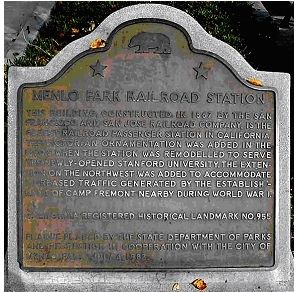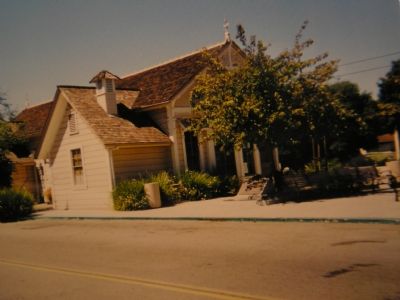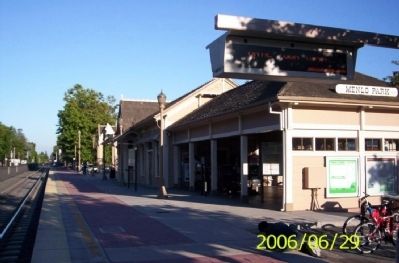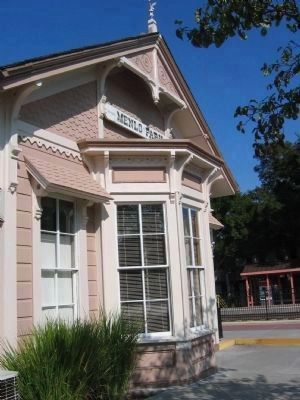Menlo Park in San Mateo County, California — The American West (Pacific Coastal)
Menlo Park Railroad Station
Erected 1983 by State Department of Parks & Recreation, City of Menlo Park. (Marker Number 955.)
Topics and series. This historical marker is listed in these topic lists: Landmarks • Notable Buildings • Railroads & Streetcars. In addition, it is included in the California Historical Landmarks series list. A significant historical year for this entry is 1867.
Location. 37° 27.294′ N, 122° 10.956′ W. Marker is in Menlo Park, California, in San Mateo County. Marker is on Merrill Avenue, on the right when traveling north. Touch for map. Marker is at or near this postal address: 1100 Merrill Ave, Menlo Park CA 94025, United States of America. Touch for directions.
Other nearby markers. At least 8 other markers are within 2 miles of this marker, measured as the crow flies. Portola Journey's End (approx. 0.8 miles away); Early People of the Creek (approx. 0.8 miles away); El Palo Alto (approx. 0.9 miles away); San Francisquito Creek Watershed (approx. 0.9 miles away); a different marker also named San Francisquito Creek Watershed (approx. 0.9 miles away); History of Tower Well (approx. one mile away); Hostess House (approx. 1.3 miles away); John Adams Squire House (approx. 1.6 miles away). Touch for a list and map of all markers in Menlo Park.
Additional commentary.
1. The Library of Congress Historical Survey Statement of Significance:
The oldest railroad station still in use in California, this station was built in 1867 by the first incorporated railroad line in the state. The coming of the railroad marked the beginning of a double transformation: the growth of the town and the development of the countryside by fashionable estates. The railroad reduced the traveling time from Menlo Park to San Francisco from 3 hours to 80 mins. This wood frame structure was built by the San Francisco and San Jose Railroad Company, the earliest incorporated line in the state. The original depot was rectangular in plan with a bay window on the south and a gable roof on the north-south axis with an additional steep gable in the center of the east side. The major decorative element was the use of flat arch drip moldings over the doors and windows, as illustrated in architectural handbooks of the period. In its form and details, this 1867 structure was typical of a popular house type of the 1850's and 60's called the "picturesque cottage." The present depot displays rich ornamentation resulting from its expansion in the late nineteenth century in accord with the rising prosperity of the region. The station was enlarged with the addition of an ell at the south west corner and a later extension to the north with its corresponding ell to the west. A wide variety of machine carved elements were applied including door and window hoods, eave brackets, shingled gable ends, incised carvings, finials, roof cresting, etc. The waiting shed at the north end was added during World War I. The depot remains a center of activity and a charming document of the changing, fanciful taste of the late nineteenth century in the Bay Area.
— Submitted April 10, 2009.
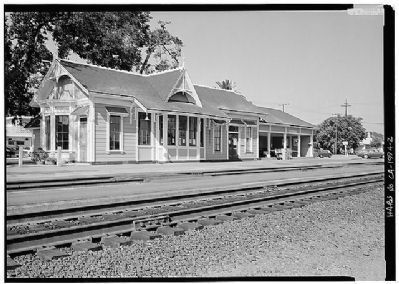
Historic American Buildings Survey-Library of Congress, circa 1994
5. Menlo Park Railroad Station - Southeast and Northeast Sides
HABS CAL,41-MENPA,4-2 (LOC)
For survey statement of significance see Comment #1
Also see attached link for additional photos.
Click for more information.
For survey statement of significance see Comment #1
Also see attached link for additional photos.
Click for more information.
Credits. This page was last revised on June 16, 2016. It was originally submitted on September 13, 2007, by Mathew H. Kohnen of San Jose, California. This page has been viewed 2,293 times since then and 29 times this year. Photos: 1. submitted on September 13, 2007, by Mathew H. Kohnen of San Jose, California. 2. submitted on September 17, 2007, by Mathew H. Kohnen of San Jose, California. 3. submitted on April 7, 2008, by Matt Gholson of Houston, Texas. 4. submitted on August 13, 2008, by Syd Whittle of Mesa, Arizona. 5. submitted on April 10, 2009. • J. J. Prats was the editor who published this page.
